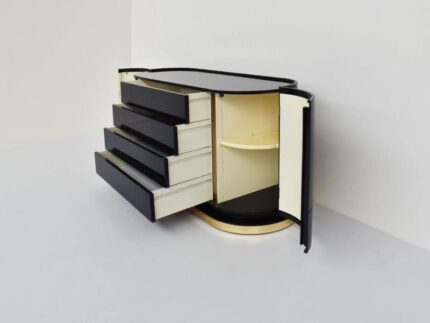Northern European manufacture dating back to the second half of the 19th century. It is a refined sculpture that almost certainly portrays the owner’s wife or lover, who commissioned a good sculptor of the time, probably a madonnaro, to create the figurehead. The work brings out numerous details, the hair framing the finely sculpted and well-proportioned face with an ecstatic expression and is gathered within a headdress whose shape recalls the statue of liberty in New York. The generous and turgid breasts are uncovered, a bunch of grapes with leaves is carved on the pronounced belly, the grape as a symbol of freedom of the senses and earthly pleasures as well as being a symbol of fertility, wealth and Abundance which brings back the life.
It was carved in oak wood, and due to its features it certainly belongs to a merchant ship, almost certainly a medium-sized brig. Its measurements are 60 inches in height, and 12 inches in maximum width. The carving was done by hand with the use of a round carving gouge. The lack of arms is typical of the figureheads of the second half of the nineteenth century, when for practical reasons, since the arms came off with a certain frequency due to sea shocks, or were damaged by the jib sheets during tacking, it was preferred do not highlight them.
A figurehead is a wooden decoration, often a female or animal figure, which was found on the prow of ships from the 16th to the 19th century. The practice was first introduced in galleons, but even older vessels often had some decoration in the prow. Like many of the austere decorations of the time, the figurehead was intended to indicate the name of the ship that housed it to people who could not read (albeit sometimes in a convoluted way), moreover they were intended to show the owner’s wealth and strength. During the Baroque period some ships boasted gigantic figureheads weighing many tons and sometimes even carrying two, one on each side of the foremast. The large figureheads, being carved in solid wood and being placed on the tip of the hull, negatively affected the ships’ navigation capabilities. This, and the high construction costs, led in the 18th century to make much smaller figureheads and even to eliminate them in the following century. After the Napoleonic wars, some figureheads began to be produced again, but they only depicted small busts and not the large figures used in the past. Clippers of the 1850s and 1860s typically featured full-length figureheads, but these were relatively small and light. The figurehead as such died with the end of the use of large-scale sailing propulsion. Early steamers had structures resembling figureheads on their bows. This practice lasted until the First World War.
-
Dimensions:Height: 60 in (152.4 cm)Width: 12 in (30.48 cm)Depth: 11.7 in (29.72 cm)
-
Materials and Techniques:Wood
-
Period:1870-1879
-
Date of Manufacture:1870
-
Condition:GoodWear consistent with age and use.
-
Seller Location:Milan, IT
-
Reference Number:Seller: LU1020232691312



























































Reviews
There are no reviews yet.